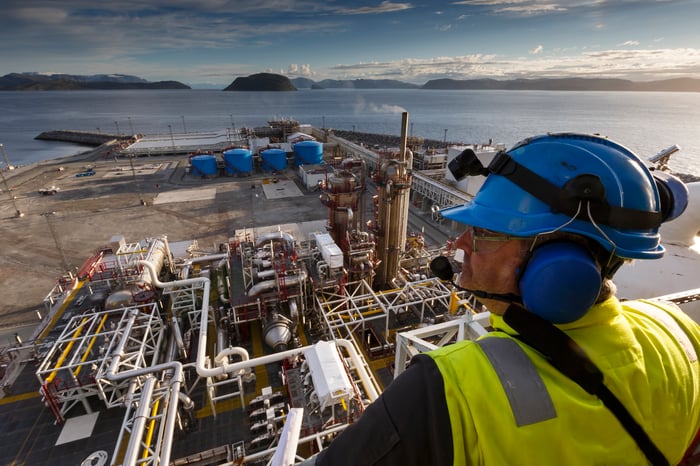The energy sector is deeply out of favor, as oil and natural gas companies pull back in the face of depressed oil prices. But the different parts of the industry aren't impacted equally. Midstream players like Canada's Enbridge (ENB -0.07%) and U.S.-domiciled Enterprise Products Partners (EPD 0.22%) are both holding up quite well. With yields of 7.3% and 9.4%, respectively, dividend-focused investors would do well to dig in here. But which is the better buy?
1. Corporate structure
One of the first things to understand about these two midstream players is that they are very different in one key way: Enbridge is structured as a traditional company, while Enterprise is a master limited partnership (MLP). MLPs come with tax issues (it would be wise to consult a tax advisor), and don't play well with tax-advantaged retirement accounts. That said, because of the partnership structure, a portion of the income investors receive is usually shielded from current taxation. There are pros and cons to MLPs that you need to understand before hitting the buy button.
Enbridge, though it uses a normal corporate structure, has its own wrinkle. As a Canadian company, its dividend is paid in Canadian dollars, so the income U.S. investors receive will change based on exchange rates. With that backdrop, let's take a closer look at each.

Image source: Getty Images
2. What they own
Both Enbridge and Enterprise are midstream giants, with market caps of $66 billion and $41 billion, respectively. They each own a broad collection of irreplaceable and hard-to-replicate assets. Enterprise's collection of pipelines, storage, processing facilities, and transportation assets is probably a bit more diverse with regard to the midstream space, while Enbridge's midstream business is largely focused on oil and natural gas transmission assets. However, Enbridge also owns a natural gas utility business and renewable power assets, which are smaller operations but provide diversification outside of the midstream space. That said, Enbridge's Mainline pipeline system provides a large portion of its revenue, so there's some concentration risk in the mix. All in all, Enterprise is the more diversified option, but perhaps not by much.
3. The dividend streaks
Enbridge has increased its dividend annually for 24 consecutive years. Enterprise has upped its distribution for 23 years running. That's basically a wash. However, their dividend growth rates are notably different. Enbridge has increased its dividend by roughly 13% a year over the past 10 years. Enterprise's distribution rose at an annualized rate of about 5%. Although both easily beat the historical growth rate of inflation over time, those vastly different disbursement growth rates are a big deal. The buying power of Enbridge's dividend is expanding at a vastly faster pace.
Enbridge Dividend Per Share (Quarterly), data by YCharts.
That said, given the current energy industry headwinds, investors shouldn't expect future growth to match those trailing-10-year figures. Enterprise, for example, stopped increasing its distribution quarterly this year. The hike at the start of 2020, meanwhile, was a token 0.06% or so. That's a conservative approach based on the market -- more on this in a second -- but it suggests that, at least for a little while, distribution growth is going to be pretty anemic. Enbridge, on the other hand, increased its dividend 11% earlier this year. But it's projecting 5% cash flow growth for 2020 at the high end of its guidance range. So while it's reasonable to expect a bigger dividend hike from Enbridge than from Enterprise in 2021, investors shouldn't expect anything like the 13% annual growth of the past.
4. The balance sheet
So far, dividend-focused investors might be leaning toward Enbridge because of its dividend growth rate. But there's another factor to consider. Enterprise has a long history of operating conservatively. That shows up most notably on its balance sheet, where its debt to EBITDA ratio of roughly 3.7 times sits toward the low end of the midstream sector. Enbridge is at the other end of the spectrum, with this leverage metric normally at the high end of the industry. Today, Enbridge's debt to EBITDA ratio is around 7 times. The Canadian company is used to operating with much more leverage, but it does increase financial risk for investors.
5. Distributions in the face of adversity
That brings the story all the way to the COVID-19-driven energy industry downturn. Enterprise was able to cover its distribution by 1.6 times in the second quarter, despite some weakness in its business. Enbridge covered its distribution by about 1.5 times, also despite some headwinds. Even in this difficult market, they are holding up fairly well on the dividend sustainability front.
Who wins?
Enbridge and Enterprise Products Partners are both well-run midstream players, and investors wouldn't be making a mistake with the purchase of either one. However, there are nuances that might lead some investors to buy one over the other. The most notable is the slow-and-steady-tortoise nature of Enterprise, which will probably be favored by conservative types. Enbridge's higher use of leverage has led to higher dividend growth over time, but it increases risk and means investors will probably want to pay a bit more attention to the company's quarterly updates. However, for investors focused on a growing income stream, that will probably be a worthwhile trade-off.






